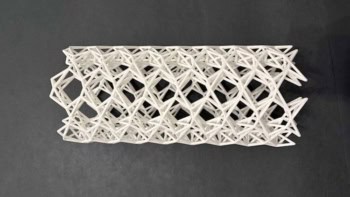
Researchers in China and the US have created an artificial material that closely mimics the hierarchical structure of tooth enamel. Hewei Zhao at Beihang University and colleagues fabricated the composite structure using specially coated nanowires, which are aligned along a single direction. The material has mechanical properties that are superior to natural tooth enamel, and the teams says it could soon be used in a wide range of engineering applications.
The enamel that coats our teeth is the hardest biological material in the human body. Known for its exceptional stiffness, hardness, viscoelasticity, strength and toughness, the material has a remarkable resistance to deformation and damage, despite being just a few millimetres thick. This unusual combination of properties stems from enamel’s hierarchical structure, which stretches from the nanoscale to the macroscale. Enamel is composed of parallel nanowires made of the calcium-based mineral hydroxyapatite. These are interconnected by a glass-like substance called amorphous calcium phosphate.
In previous studies, researchers aimed to mimic this structure in artificial materials. So far, however, the assembly of hierarchical structures across multiple scales has proven challenging – and limited to sub-millimetre scales.
Strong chemical bond
Zhao’s team began the process of making their material by synthesizing hydroxyapatite nanowires roughly 10 µm in length. They then coated the nanowires with a layer of amorphous zinc peroxide, which forms a strong chemical bond with the hydroxyapatite. The movements of the coated nanowires were then restricted by intertwining them with the stringy molecules of polyvinyl alcohol; after which the entire mixture was frozen.
When the team applied a bi-directional temperature gradient to the mixture, ice crystals grow in parallel layers. Subsequently, this forced the intertwined nanowires to occupy the gaps between ice layers while orienting themselves along a single direction. Finally, the material was freeze-dried and compressed. This resulted in a dense artificial tooth enamel, in which parallel columns of coated nanowires were rigidly bonded together.

Impurities toughen tooth enamel, but could make teeth vulnerable to decay
Through stringent mechanical tests, and subsequent analysis with electron microscopy, Zhao’s team found that their composite structure could endure strains exceeding 140 MPa; and fractional length changes of 1.8%, before fracturing. On macroscopic scales, this gave the material a stiffness, hardness, strength, viscoelasticity and toughness that exceeded those of both natural enamel, and previous enamel-inspired materials.
What is more, Zhao and colleagues showed how the material could be easily manufactured in bulk and machined into desirable macroscopic shapes. Through the future development of suitable manufacturing techniques, the team believes that artificial enamel could be used across a variety of engineering applications where material rigidity is required.
The new material is described in Science.



